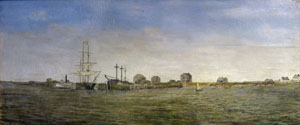Historical Paintings of Woods Hole and Falmouth by F. L. Gifford

Woods Hole Waterfront, 1870
This picture was sketched by Mr. Gifford in 1870, painted in 1892 and copyrighted. The tiny building at the extreme left is the sheep shed on Long Neck (0) and to the right is William Robinson's house (1). The cluster of buildings just over the bow of the side-wheel steamer "Monohansett" is Seth Robinson's house and barn (2) (3) called the "Yellow House", and the house of Sanford Harendeen (4) who was boss cooper for Elijah Swift. The "Monohansett" is seen after she has towed in the whaling vessel "Hobomok" to Bar Neck Wharf, following a four years' voyage. The flag at the masthead is the private pennant of the owner Elijah Swift. The unrigged ship at the wharf is "Commodore Morris" which was built on the shore to the right of the wharf. Immediately behind "Commodore Morris" is the spar shed and store house (53) on Bar Neck Wharf. The Candle House (11) can be seen behind the spar shed. To the right of the Candle House is the Bake House (13) with the sawpits in the foreground and immediately to the right of these are the Boat Shed (12) and the Coopering Shop (14) which also contained a Commercial Hall and a Sail Loft. To the right of the small sailboat is Braddock Gifford's Blacksmith Shop (15) and in the distance Martha Holly's house (20) and Captain Benjamin Edwards' house (19). Captain Edwards had command of the buoy setting sloop "Active". Next on the right is the wooden bridge across the entrance to Eel Pond, and Marshall Grew's boat shop (1672). In the distance behind Marshall Grew's house and barn (16) is the Ezekial Swift, Sr.'s house (17) and on the extreme right Andrew Y. Davis' barn (18).
William Robinson's house (1) was built in 1700 and was located on the east end of Long Neck, now Penzance Point. Braddock Gifford's house (7) was built in 1833 while John Robinson's house (6) was built in about the year 1843. The Candle Factory (11) was built in the year 1839 during which time a northeast gale with gusts to 80 miles per hour tore off the new roof and blew it into the harbor. Ezekial Swift, Sr.'s house (17) was built in 1843.
Shown on Bar Neck Wharf, in the central foreground of this picture, are from 500 to 1,000 barrels of sperm oil, the average amount kept in storage for lamp fuel and candle making. To the west of the Candle Factory (11) is the stone “try house" (10). The southern portion of this building, about 50 feet long and 30 feet wide, had a glass roof, similar to a green house, under which the raw oil was bleached by the sun in long shallow pans before it was used in the manufacture of candles.
In front of Braddock Gifford's Blacksmith Shop (15), near the shore of the harbor, there was a steam box about 3 feet square and 25 feet long used for softening planks before bending them into the proper form to fit a vessel's sides. To the right of the steam box, on the present site of the Community Hall, was the sawpit where ships' planking was cut by hand from logs and timbers. On the wharf beside the sawpit there are several piles of live oak timber, much used in ships because of its great toughness and strength.
Some of the more prominent craftsmen among the hundred or more who worked in the Bar Neck Shipyard were Sanford Harendeen, master cooper; Christopher Bearse, cooper; Braddock Gifford, master smith; Owen Eldridge, Lewis Swift, John Robinson, iron workers and blacksmiths. The master mechanic and shipbuilder was a Mr. Lawrence. Charles E. Hatch and Otis Hatch were sailmakers.
The text above is from Historical Paintings of Woods Hole, by Franklin Lewis Gifford (Woods Hole Public Library, 1962). The numbers in parentheses refer to Gifford's "Map of Woods Hole as of 1845," which you can see by clicking here.
